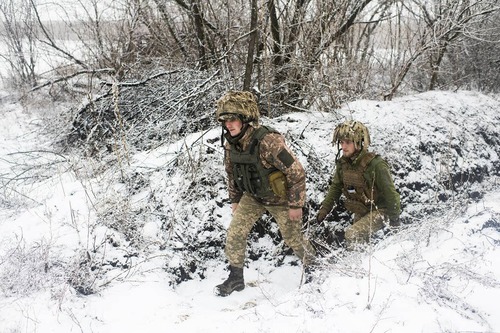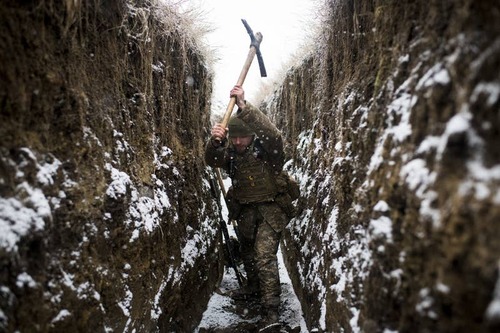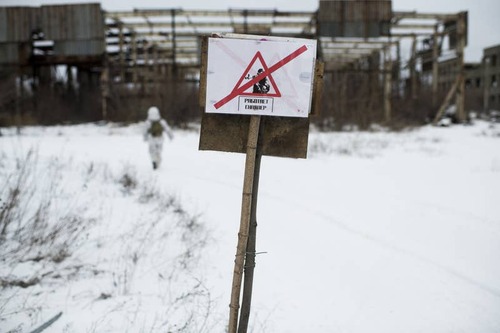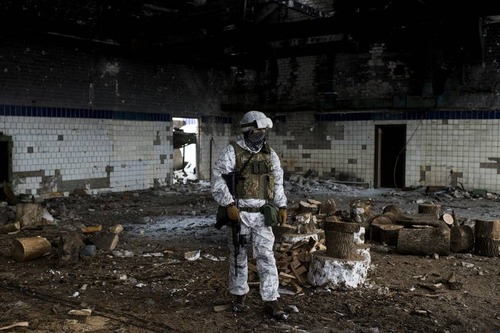
UKRAINE “Hell Is Empty. All The Devils Are Here”:
A Dispatch From The Trenches In Ukraine
Current fighting between Ukraine and Russia has been more frequent and intense than previously known. Here’s how soldiers are avoiding sniper fire, digging trenches, and preparing for war.

Denis Ivashchenko, a 21-year-old officer, right, and another soldier move through a trench at a frontline position on Jan. 18, 2022, in Niu-York, Ukraine.
NIU-YORK, Ukraine — In this little town in eastern Ukraine, where residents on the front line of Russia’s eight-year-long war never sleep a sound night, it was soldier Ihor Tychyna’s turn to keep watch.
It was just after 2 a.m. on Dec. 27, and light snow was falling. The lanky 20-year-old of the 95th Air Assault Brigade was stomping through the neck-deep maze of trenches when he reached a shallower segment of the channel. With the mud squishing beneath his feet, he almost certainly didn’t hear the quiet chirp of a sniper’s bullet, fired from a bluff 800 meters away before it penetrated the left side of his head just 1 inch below his helmet.
“It was a Mission Impossible kind of shot,” Denis Ivashchenko, a 21-year-old officer to whom Tychyna reported, told me this week when I visited his brigade’s positions. “It was dark and snowing, and he was moving. The sniper had to be a professional.”
Ivashchenko found Tychyna moments later, slumped over. There was a hole in his skull and blood was pooling beneath him in the fresh snow. Tychyna was rushed to a nearby hospital but died New Year’s Day, the first Ukrainian soldier to do so in 2022. He’s now one of the roughly 14,000 people killed since the war started in spring 2014.
Three weeks later, Andriy, a 21-year-old soldier with a carefully trimmed beard, was digging with a pickax and shovel at the spot in the trench where Tychyna was shot.
“It should be deep,” Ivashchenko said, monitoring Andriy’s work.
Andriy shoveled dirt and tossed it over his shoulder. Now, the top of his helmet was nearly a foot below ground level.
.png) This is what the war in eastern Ukraine, a region known locally as the Donbas, has been like since an uneasy stalemate took hold in winter 2015, following nearly a year of all-out war. It is grinding, bloody, and senseless. Nobody here has been on the offensive for years. Most battlefield deaths lately have been from sniper fire and landmines. A handful of soldiers die every month. But danger still lurks around every trench corner. Soldiers here know to never let their guard down. But after eight years of this, sometimes they do.
This is what the war in eastern Ukraine, a region known locally as the Donbas, has been like since an uneasy stalemate took hold in winter 2015, following nearly a year of all-out war. It is grinding, bloody, and senseless. Nobody here has been on the offensive for years. Most battlefield deaths lately have been from sniper fire and landmines. A handful of soldiers die every month. But danger still lurks around every trench corner. Soldiers here know to never let their guard down. But after eight years of this, sometimes they do.
It is Ukraine’s forever war, where generations have fought and come of age. Fathers who first took up arms in 2014 now have sons like Andriy, Denis, and Ihor who were teenagers when Moscow annexed Crimea and invaded the Donbas eight years ago. (Andriy, who comes from a military family, said his father fought in Debaltseve, a 2015 battle that saw the Ukrainian military encircled and pounded by heavy artillery and that turned the tide of the war in Russia’s favor. Hundreds of Ukrainian soldiers died in what was one of the biggest single-battle losses for Kyiv. Andriy’s father was lucky to escape.) Today, these young men are the first line of Ukraine’s defense at the front.
I spent a week embedded with Ukraine’s military in three strategic positions along the 250-mile front line — in Niu-York, Avdiivka, and Opytne — to find out what they have seen and how they are preparing for an attack. I found that the fighting in the Donbas has been more frequent and intense than has been reported by both sides, with daily skirmishes using small arms, sniper duels, and provocations with smaller mortar systems. Soldiers in three different positions all noted the return of heavy artillery to Russia-backed positions. In some locations, fresh trenches are being dug.

Andriy, a 21-year-old Ukrainian soldier, works to deepen a trench where fellow soldier Ihor Tychyna, 20, was shot by a sniper at a frontline position in Niu-York, Ukraine.
The United States and its NATO allies warn that they may soon face the full force of the Russian military and renewed fighting likely on a scale greater than what’s been seen so far, as the Kremlin gears up for what appears to be a new invasion of Ukraine.
“My guess is he will move in, he has to do something,” President Joe Biden said about Russian President Vladimir Putin on Wednesday. A full-scale invasion of Ukraine would be “the most consequential thing that’s happened in the world in terms of war and peace since World War II,” Biden added, with the risk of it spreading beyond the Ukrainian borders where it “could get out of hand.”
For weeks, Russia massed more than 127,000 troops and tons of military equipment along Ukraine’s border, a Ukrainian intelligence official told me Wednesday, ratcheted up its rhetoric and disinformation campaigns against Kyiv, and allegedly hit government agencies with cyberattacks. Satellite images and posts on social media have tracked the buildup in almost real time.
“Ukraine does not want a war, but Ukraine must always be ready for it,” President Volodymyr Zelensky said Wednesday in a televised address during which he urged Ukrainians to remain calm. “We are not afraid because we protect our land. We will not give up because there is nowhere to run.”

Many soldiers said that Russia’s latest military moves make them nervous; there’s palpable anxiety mounting on the front. But Ukraine’s troops have been preparing for this moment for several years.
“We’re not scared. We’ve had time to grow stronger. We’re real soldiers now,” 24-year-old Platoon Commander Valentin Trusov told me in the village of Opytne, where just about 28 residents remain, living without electricity and heating.
I reached him from a desolate road where it’s necessary to race at high speed in order to avoid fire. In peacetime, this drive would be an idyllic one, with golden fields of sunflowers and tall grass lining the highway. Now soldiers here refer to it as a “road of life” as it offers an escape from danger. But sometimes it’s also the “road of death.” Two troops were killed by an anti-armor missile on it last summer while on a supply run.

A Ukrainian soldier uses a scope to observe enemy lines at a frontline position; Ukrainian soldiers return with supplies on their way to a frontline position on Jan. 18, 2022, in Opytne, Ukraine.
Shortly after I arrived, a small volley of grenades fired from an automatic grenade launcher came in. Trusov told me to keep my head down as we toured his unit’s forward-most positions. The destroyed Donetsk Airport, once a glimmering symbol of progress in the rough-and-tumble coal mining region, was just 600 meters away. Through a scope, I could make out craters on the runway left from fighting more than seven years ago.
“They fire on us all the time. Every day,” he said, contradicting reports in recent days that there have been no violations of a ceasefire that has existed in name since February 2015.
Trusov said that lately his troops have increasingly been targeted with 82 mm and 122 mm artillery. Pointing southeast toward the airport, which Russian proxy forces hold, he said enemy battle tanks were positioned behind a tree line.
The Ukrainian military is indeed significantly stronger and much larger than it was in 2014, when Russian forces seized the Crimean peninsula without a fight and then used special forces and separatist proxies to take over a swath of the Donbas roughly the size of New Jersey. Today, with more than 200,000 active-duty troops, Ukraine’s army is among the largest in Europe. Western weapons deliveries and NATO training have also helped to modernize Ukraine’s military.
But it’s still dwarfed and outmatched by Russia. Should Putin launch an all-out offensive with the estimated 100 battalion tactical groups, including soldiers from his ground forces, airborne brigades, and the marines positioned nearby, there is little that Ukrainian forces could do to stop them.
Nevertheless, Ukrainians say they are willing to try and even to die to ensure the survival of their country.
Amid the ruins of a former tire factory on the outskirts of Avdiivka, I linked up with the 25th Airborne Brigade and First Lt. Ivan Skuratovsky, a 30-year-old married father of two. After an unsuccessful hunt for an engineering job, he had the unfortunate luck of joining the army just months before the war broke out.
As a 22-year-old in 2014, Skuratovsky fought in some of the fiercest battles as a gunner on a Ukrainian version of the US Bradley Fighting Vehicle. He survived, but his unit lost seven soldiers and the battalion another 25 between August and November that year. Now he’s one of the most senior people in the brigade.
The 25th has been positioned in Avdiivka since August. Known as the Promzona, the area has been the site of some of the most intense fighting over the years. Almost everything here is pockmarked from artillery shells, shrapnel, and machine-gun fire. It’s a Mad Max–like scene with the burned husks of cars and machinery littered across the grounds. Feral dogs roam the wreckage, and other than their growls and the whipping winds, the only sounds you hear between the sporadic cracks of gunfire and thuds of mortars is the eerie creak of sheet metal.
"Hell is empty. All the devils are here."
I followed soldiers here through a maze of trenches and found Oleh, a 43-year-old commander, fiddling with his machine gun as I approached his dugout. A sign at its entrance read, “Hell is empty. All the devils are here.” Dressed in snow-white camouflage, he pointed through a small wooden cutout to where his enemy stands just 50 meters away. Through a scope, he can sometimes see their breath rise above their open trenches. It’s so close that he can also hear the clanking of weapons and conversations being had by the very people who are trying to kill him.
“We can hear them prepare their provocations,” he said. Russia-backed fighters often take potshots at the Ukrainian soldiers in hopes of getting them to return fire and, as Oleh put it, “pick a fight.”
He can also hear them “curse and complain” when they’re given orders to dig new trenches or carry out other commands, giving the impression that morale among the local Russia-backed forces is low.
I’ve seen evidence of that in photos provided by a source and on social media accounts of those still living in the occupied city of Donetsk: advertisements offer monthly payments of around $300 for new recruits to join the “Armed Forces of the Donetsk People’s Republic” — which is essentially an arm of Russia’s military. Composed mainly of local Ukrainians who chose Moscow’s side, they have been used as cannon fodder in key battles, sustaining most of the casualties, while Russia’s regular forces are used sparingly, often when their proxies are losing a fight in order to turn it around.
Lately, however, there has been an uptick in sniper fire, as well as an increase in reconnaissance and sabotage.

A Ukrainian soldier walks past a sign warning of snipers in a destroyed industrial area at a frontline position on Jan. 17, 2022, in Avdiivka, Ukraine.
“At this moment, snipers fire and machine guns cover his position” by masking the sound of the shot, Skuratovsky told me.
On Dec. 31, three hours before midnight, Junior Sgt. Stanislav Bohuslavskiy, 23, was on patrol when he was hit in the head by a sniper’s bullet. “He made a mistake” by letting his guard down for just a moment, Skuratovsky said. “It was a really good sniper. And we think he had thermal vision on his rifle.”
Bohuslavskiy, who was remembered by his comrades as a funny guy who was built like a club bouncer, was the last soldier killed in 2021.
To Skuratovsky, the manner of his death suggests real professional soldiers may have returned to the front here, possibly in preparation for a new attack.
ut until that happens, Skuratovsky’s men are unable to freely return fire. For the past several months, they have been under orders to not fire back except in serious circumstances when they’re under direct threat. If it’s just a potshot, they are supposed to let it go. The order, which trickled down from Zelensky to the military’s top brass, is meant to try to keep down the intensity of the fighting here and elsewhere along the front so that Russia cannot find a pretext to attack.
The soldiers hate this. When asked about it, they clench their teeth and complain.
“It’s hard for our guys to understand,” Skuratovsky said, recognizing the frustration of his soldiers.

Ivan Skuratovsky, a 30-year-old first lieutenant, in a destroyed industrial area at a frontline position on Jan. 17, 2022, in Avdiivka, Ukraine.
In September and October, Skuratovsky said, they did meaningfully return fire after being bombarded by “really heavy artillery,” including 122 mm shells.
Most days, though, they take much more than they give. Lately, it’s been a lot of grenade fire from automatic systems and underbarrel launchers. “They’re like little mortars,” Skuratovsky said. “But they can do a lot of harm.”
Inside a bunker made of logs and adorned with children’s drawings sent from across Ukraine to keep up the troops’ morale, Skuratovsky stood among several computers and printers. He complained that he and his soldiers push more paper than they pull triggers at the moment.
“We have a joke,” he told me. “A soldier calls on the phone and says, ‘Commander, they are attacking us. Can we return fire?’ And the commander says, ‘Wait, we must file a report first.’”
If US and NATO intelligence assessments are right and Russia is about to move into Ukraine anew, the soldiers may very soon have no choice but to fire.
Mykhailo, a gravelly voiced 25-year-old commander and father who is expecting his wife to give birth to their second child in the coming weeks, said he’s going to stand his ground no matter what comes at him from across the front line. A religious man who recounted surviving an attack when a hail of bullets all hit a narrow cement column he took cover behind, completely missing him, he wants to ensure that Ukraine will continue to exist for his children.
“We will be motivated to fight until the last of our land is liberated,” Mykhailo said, “and not before we can again stand on the borders of all of independent Ukraine.”â
Inna Varenytsia contributed reporting.

Christopher Miller is a reporter for BuzzFeed News and is based in New York
Contact Christopher Miller at christopher.miller@buzzfeed.com.
Got a confidential tip? Submit it here.
TP

